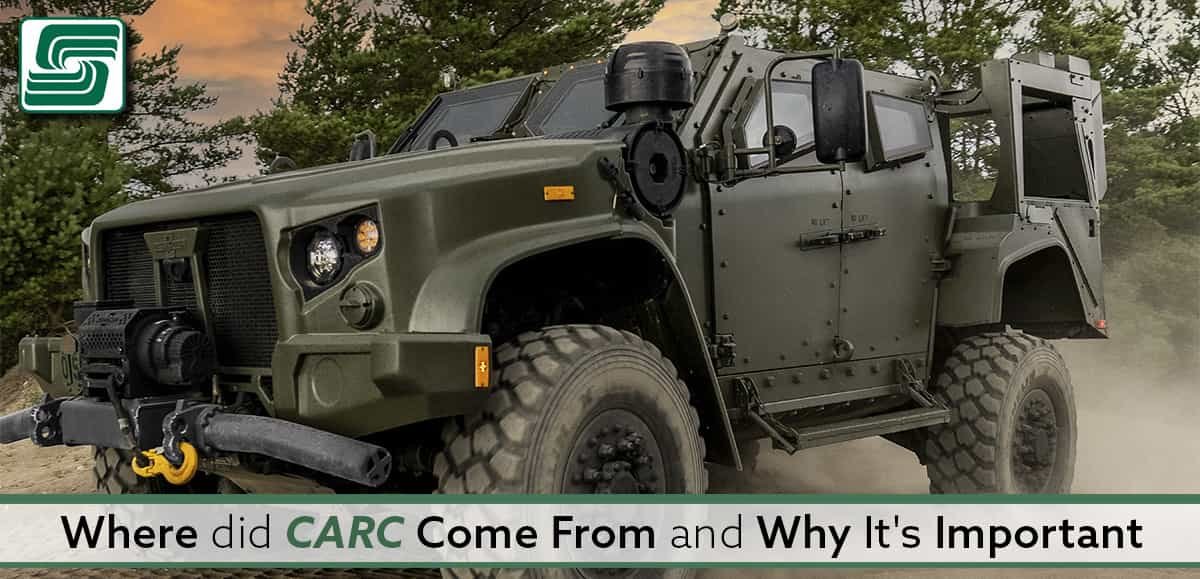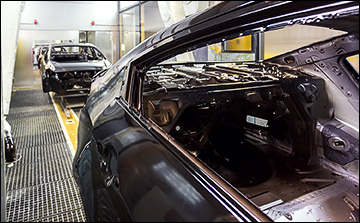
The procedure is the same for both vehicles, at least superficially. The intricacies, on the other hand, differ.
Has a vehicle with a unique paint job or eye-catching graphics caught your attention while driving down a highway? Unless that vehicle has a particularly unique color scheme or graphics, I doubt you would notice it.
Instead of driving down a highway, you're now home watching TV. You find a documentary or news story about our military on the small screen. Have you wondered how they are painted?
Are you aware of the various painting methods used in the military versus civilian vehicles?
The procedure is the same for both types of vehicles, except for the minor details.
Painting Commercial Vehicles
Much has changed since the first cars rolled off Henry Ford's assembly line, they were painted by hand. As good as those painters were, they wasted paint, and the application wasn't uniform.
 These problems were solved when robotics revolutionized the auto industry by automating paint lines in US auto plants.
These problems were solved when robotics revolutionized the auto industry by automating paint lines in US auto plants.
There is a preparation phase for any painting procedure. In our case, components start with a degreasing stage, removing any contaminants remaining from the manufacturing process.
Next, the metal is treated and coated with zinc providing better corrosion protection and greater adhesion for the upcoming painting steps.
After taking these baths, a primer coat is added. Components are introduced to an electrostatic process using a current that attaches paint more economically than a handheld spray gun. This e-coat uses less paint and provides more excellent uniform coverage than earlier methods.
The second layer is adding a clear coat to the parts. The clear coating not only protects the vehicle from sun damage, but it also plays a crucial role in minor dings. The clear coat takes the hit instead of the paint. Any chance for rust diminishes when preventing moisture from reaching the metal substrate.
CARC: Military Coating
What does CARC stand for? Chemical Agent Resistant Coating. CARC is a matte military version of the polyurethane paints developed and used on commercial products.
What makes CARC different than commercial coatings is how it protects chemical and biological contaminants from soaking in. Preventing absorption is key. Dangerous contaminants bead up on the surface, making decontamination relatively easy.
The CARC finish is resistant to fading and more durable than the paint the military used in the past. The new process lasts up to four times longer, meaning vehicles wouldn't need to be repainted, saving maintenance costs.
Vehicles aren't the only pieces of equipment requiring CARC paint. Missile launchers, rotary and fixed-wing aircraft, artillery pieces, water purification units, generators, forklifts, and communication vans also receive the military coating.
CARC Evolution
There are several theories of how the concept of CARC developed. One theory tells of the story of dismantling and analyzing a captured Russian tank in the early 1970s. Results showed the Russians possessed a coating system providing easy decontamination against chemical attacks.
The US Army adopted the CARC process in 1983 and issued guidelines to transition from older methods to CARC. This transition began in earnest in 1985.
In his book, America's Struggle with Chemical-Biological Warfare, Albert J. Mauroni wrote about the importance of survivability for equipment and personnel:
As part of survivability studies conducted to see how military equipment stood up to CB agents and decontaminates, scientists had observed that oil-based military paints had a tendency to absorb chemical agents, holding them in the paint and extending the standard contamination times.
Chemical Agent Resistant Coating (CARC) was developed in early 1980 combatting this problem. By utilizing an alkaloid-based polyurethane paint instead of oil-based paint, military equipment could resist chemical agent absorption, making decontamination easier. The program successfully passed its agent tests and a final in-progress review in 1981. This feature became Army policy in 1983 for all equipment.
CARC Specifications
The US Department of Defense (DoD) outlined new specifications vendors are required to meet for the primer and topcoat:
- Type I Coating
- —epoxy-based primer, chemical agent resistant coating.
Type II Coating
- —an epoxy-based primer for interior components, chemical agent resistant coating,
Type III Coating
- —camouflage top coatings, chemical agent resistant coating. The primary colors required by the ARL are 383Green, 686 Tan, Aircraft Green, Black, and Brown.
Type IV Coating
- —coatings for ammunition containers.
A company seeking to work with the DoD must undergo a difficult, rigorous vetting process.
CARC Benefits
These military coatings benefit our armed services in many ways, but there are three primary benefits:
Chemical Resistance
Military vehicles are protected from biological and chemical agents using CARC coating. People and equipment are protected from such weapons because chemicals cannot penetrate the vehicle's exterior. Military coatings protect people and equipment inside those vehicles by protecting them from chemical weapons.
Reduction in Signature/Camo
Since you cannot see what you cannot shoot, CARC provides signature-reducing properties that diminish the effectiveness of enemy systems.
Improved Durability
Military vehicles using CARC benefit from the durability the finish provides. Using nonsiliceous polymeric beads, CARC is a water-dispensible surface providing superior mar resistance, weather durability, and flexibility.
CARC-Related Health Concerns
The CARC paint of early ages contained hazardous volatile organic compounds (VOCs) that were dangerous to people and the environment with constant exposure.
CARC benefits from continuous research and improvements in painting methods and technology, which are subject to stringent guidelines from vendors to ensure homogenous painted parts with consistent applications and improved VOC emissions.
In Sum
Production of CARC components by US metal fabrication companies is crucial in maintaining quality and effectiveness without driving up costs.
Modern military coatings are much higher in quality than those used generations ago. CARC paints and procedures have evolved and improved over the years.
Paint on a vehicle is not considered significant other than for aesthetic reasons. However, looking more closely, you will see that CARC paints offer a layer of protection that civilians would not consider necessary.
It is imperative that any branch of our military not be subject to chemical or biological attack. If they are, CARC's importance becomes glaringly obvious.